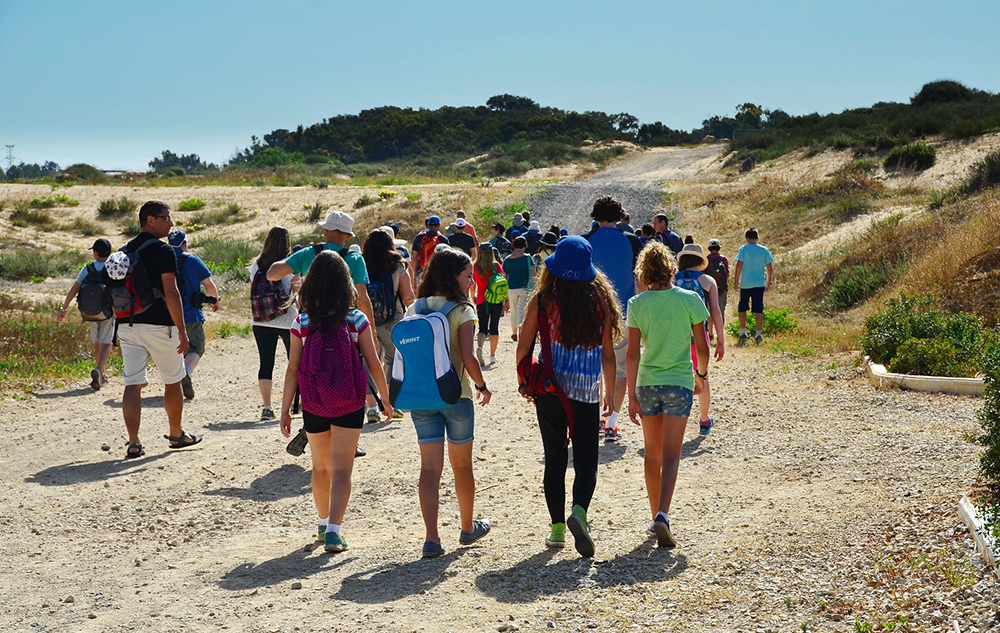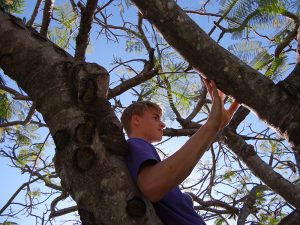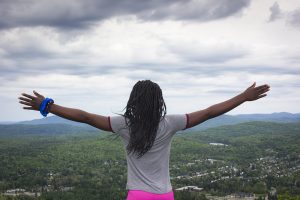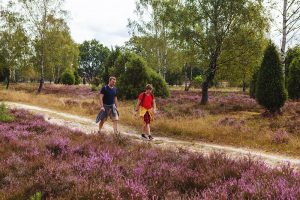
The Value of Nature during the COVID-19 Pandemic
The impact of COVID-19 on our daily routines and habits has been life changing. It’s led us into different ways of living, including how much time we spend together with some and how much time we spend apart from others. It’s especially impacted our time spent outside and our contact with nature.
As we move into the summer months most of us look forward to the warmth and rhythms of summer time. For those of us living and working with children and adolescents, summer usually opens up a season of greater flexibility in engaging young people in outdoor activity. This is important because experiences in the natural world play a significant role in their growth and development (Louv, 2011).
Even before the pandemic and ‘stay at home’ mandates, most of us have experienced increasing isolation and disconnection from the natural world. Young people in particular are experiencing less time in unstructured, creative play in the outdoors than ever before in history (Louv, 2008). Those who are in care, especially in highly structured or restrictive environments, are impacted by this even more. All of this is intensified with physical distancing requirements and directives to stay close to home.

Experiences in Nature Impact a Child’s Development
Exposure to nature has a significant impact on multiple developmental domains, including physical agility, mental health, and stress management. In one study, researchers found that preschoolers who play on uneven, natural surfaces surrounded by trees and rocks over the course of a year demonstrated greater agility and balance control than others who had access only to flat playground surfaces (Burdette & Whitaker, 2005). Another study found that when given the choice, adolescents tend to choose natural environments to refocus and center themselves (Korpela, 1992). This direct contact with nature has also been found to help the brain recover from mental fatigue and restore the ability to focus attention (Kaplan & Kaplan, 2005). Young people who live in settings surrounded by nature were also found to experience less distress from adverse life experiences than those living in more urban environments going through similar adverse experiences (Wells & Evans, 2003).
These effects span multiple areas in the developing brain, including the cerebellum (e.g. physical agility and motor control), limbic system (e.g. stress modulation and response), and the frontal cortex (e.g. emotional control and attention). Fresh air and open space play an important role in a healthy childhood.
So, what can we do differently in these coming summer days and nights? Of course, the public health directives will guide where and with whom we should go. Yet, as much as we are able, we can engage those we support in direct, unstructured, and shared experiences in nature.
- Create experiences that include direct contact with nature
 Every child has a basic need to explore, play, and interact with the natural world. This takes place in a variety of forms depending on the personality of the individual, the influences of culture, and the demands placed on them from their environment. This direct exposure to the elements of nature is a critical component in the developmental task of developing our sense of place in the world (Freeman, 2013). Challenges faced by some kids, such as multiple placements, displacement, and homelessness, make this even more challenging.
Every child has a basic need to explore, play, and interact with the natural world. This takes place in a variety of forms depending on the personality of the individual, the influences of culture, and the demands placed on them from their environment. This direct exposure to the elements of nature is a critical component in the developmental task of developing our sense of place in the world (Freeman, 2013). Challenges faced by some kids, such as multiple placements, displacement, and homelessness, make this even more challenging.
Think of ways you can get your kids directly in touch with the natural environment around them. It doesn’t have to be a fancy or expensive outing – it may be a sandbox in the backyard or a walk through an open area. The more direct (and sometimes the muddier) it is, the better: “Dirt is proof that we are living life, participating, exploring and experiencing – something kids today encounter less than our generation did” (Persil, 2013). As you get out, try to set aside the worries and stress that life brings and simply enjoy the moment as it unfolds. These experiences, as brief as they may be, have the potential to help all of us feel more centered and balanced.
- Provide unstructured experiences in nature
Unstructured doesn’t necessarily mean unsupervised, but it may mean loosening up on the time limits, boundaries, and overly organized agenda. If you’re caring for multiple kids or a group, give them opportunity to explore, experience teamwork, and experiment with problem solving.
Recently I observed a group of kids work together to build a dam in a small creek near our neighborhood. They each took on various roles, exchanging them as the group developed and tasks were completed. They gathered rocks and placed branches, mingled their working and playing with occasional splashes at one another, and in the end seemed to feel the satisfaction of their accomplishment together as they sat back and watched their creation.
The century old classic, The Story of a Sandpile shares a perspective of a summer ritual discovered by a group of young boys. It tells the story of the development of a pile of sand by young boys without the interference of adults. At the end of the summer the parents assessed that the experience had “been of about as much yearly educational value to the boys as the eight months of school…[and] the boys have grown more companionable and rational, learned many a lesson of self-control, and developed a spirit of self-help” (Hall, 1897, p. 19-20). It reminds us that the simplicity of unstructured time can work to engage imagination, develop peer relationships, and nurture group development.
Don’t give up on all the structured activity. Organized sports are one thing many kids are longing to return after the pandemic passes. But make sure they get some sort of unstructured time for exploration and discovery.
- Share your experiences outdoors together
 Outdoor adventures are prime opportunities for relationship building. This is something every child needs and even more so those who have experienced disrupted relationships. Sharing an experience simply means being with one another for the experience of a sunset, a walk through a eucalyptus grove, or digging in the sand.
Outdoor adventures are prime opportunities for relationship building. This is something every child needs and even more so those who have experienced disrupted relationships. Sharing an experience simply means being with one another for the experience of a sunset, a walk through a eucalyptus grove, or digging in the sand.
The intentional use of outdoor activities can be used as a ‘common third’, a concept from social pedagogy which views shared activity as a means to strengthen a relationship and develop new skills. We can “teach by the example of our own attention and wonder…being there with them as they climb on rocks, play in streams and waves, dig in the rich soil of woods and gardens, putter and learn” (Nabhan & Trimble, 1994, p. 31). There are endless opportunities to do things together outdoors without overly structuring the time. What’s one you might experience with a child today?
Getting outside and involved in direct, unstructured, and shared experiences in nature can provide a range of developmental benefits for the growing child and adolescent. What will you do in the coming weeks to maximize those benefits for those in your care?
References
Burdette, H. & Whitaker, R. (2005). Resurrecting free play in young children: Looking beyond fitness and fatness to attention, affiliation and affect. Archives of Pediatrics and Adolescent Medicine, 159(1), 46-50.
Freeman, J. (2013). Developing a sense of place and time. Child & Youth Care Online, 175, 23-25.
Hall, G. S. (1897). The Story of a Sand-Pile. New York, NY: E. L. Kellog & Co. Retrieved from https://archive.org/download/storyofsandpile00hall/storyofsandpile00hall.pdf
Kaplan, R. & Kaplan, S. (2005) Preference, restoration, and meaningful action in the context of nearby nature. In P. Barlett (Ed.) Urban place: Reconnecting with the natural world (271-298). Cambridge, MA: MIT Press.
Korpela, K. (1992). Adolescents’ favorite places and environmental self-regulation. Journal of Environmental Psychology, 12, 249-258.
Louv, R. (2008). Last child in the woods: Saving our children from nature-deficit disorder. Chapel Hill, NC: Algonquin.
Louv, R. (2011). The nature principle: Human restoration and the end of nature-deficit disorder. Chapel Hill, NC : Algonquin.
Nabhan, G. & Trimble, S. (1994). The geography of childhood: Why children need wild places. Boston, MA: Beacon Press.
Persil. (n.d.). Kids Today Project. Retrieved from http://www.persil.co.uk/kidstoday
Wells, N. & Evans, G. (2003). Nearby nature: A buffer of life stress among rural children. Environment and Behavior, 35(3), 311-330.
About the Author
James Freeman, MA, CYC-P is the director of training at Casa Pacifica Centers for Children and Families.
An earlier version of this article appeared in CYC-Online (vol. 184, p. 30-33).



